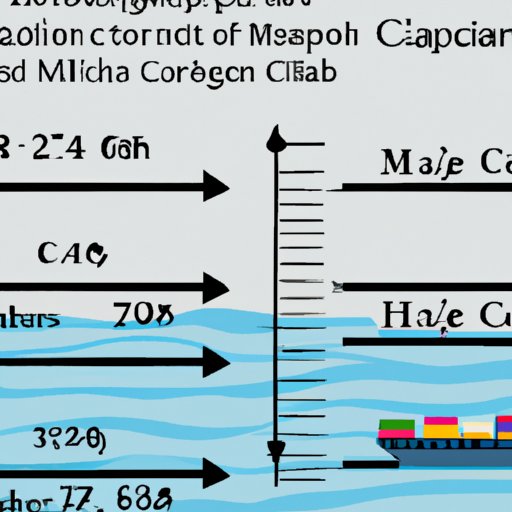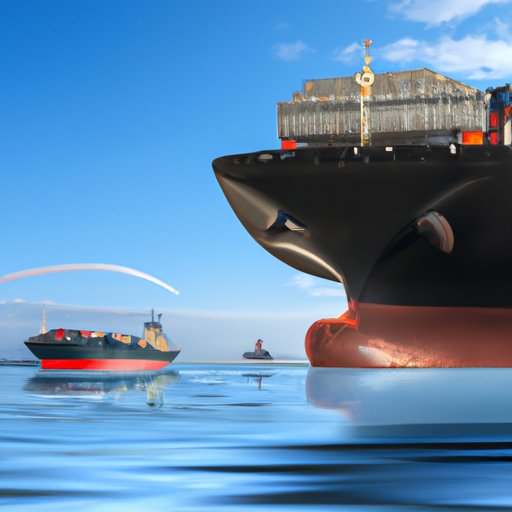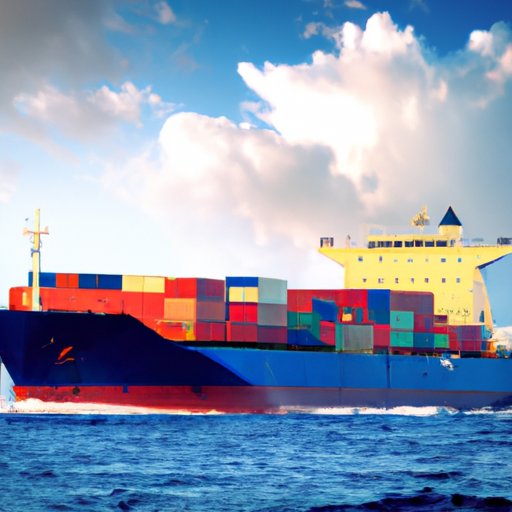Introduction
A cargo ship is a commercial vessel that transports goods and materials from one place to another. The size of the cargo ship can vary considerably, ranging from small vessels carrying only a few containers to large vessels capable of carrying thousands of containers. Cargo ships are essential for global trade, connecting ports all over the world and transporting goods across continents.
In this article, we will explore how far a cargo ship can travel in one day. We will examine the factors that affect the distance a cargo ship can travel in 24 hours, including speed, different types of cargo ships, and the impact of wind and sea currents. We will also look at some of the world’s longest cargo ship journeys and how modern cargo ships compare in terms of efficiency and maximum travel range.

Examining the Factors That Affect How Far a Cargo Ship Can Travel in One Day
There are several factors that can affect how far a cargo ship can travel in one day, including speed, different types of cargo ships, and the impact of wind and sea currents.
Speed
The speed of a cargo ship is an important factor that affects its travel distance. Generally speaking, the faster a cargo ship travels, the further it can go in a single day. However, there is a limit to how fast a cargo ship can travel, and this depends on the type of cargo ship as well as the conditions of the ocean.
Different Types of Cargo Ships
Cargo ships come in various sizes and shapes, and each type of cargo ship has its own average speed and maximum speed capabilities. For example, tankers, which are used for transporting liquids such as oil and gas, typically have an average speed of 10 to 14 knots (11.5 to 16.1 mph). Bulk carriers, which are used for transporting dry bulk goods such as coal and grain, typically have an average speed of 12 to 16 knots (13.8 to 18.5 mph). Container ships, which are used for transporting containers filled with goods, typically have an average speed of 15 to 20 knots (17.3 to 23 mph). Car carriers, which are used for transporting cars, typically have an average speed of 10 to 15 knots (11.5 to 17.3 mph).
Impact of Wind and Sea Currents
The wind and sea currents can also affect the travel distance of a cargo ship. Strong winds can slow down a cargo ship, while favourable winds can help it move faster. Similarly, strong sea currents can slow down a cargo ship, while favourable currents can help it move faster. In addition, storms and other weather conditions can also affect the travel distance of a cargo ship.

Exploring the Impact of Speed on the Distance a Cargo Ship Can Travel in 24 Hours
As mentioned above, the speed of a cargo ship can have a significant impact on its travel distance. The average speed of different types of cargo ships can vary, but the maximum speed capabilities of modern cargo ships can be quite impressive. For example, some of the newer cargo ships are capable of reaching speeds of up to 30 knots (34.5 mph), which is significantly faster than the average speed of most cargo ships.
Investigating the Different Types of Cargo Ships and Their Average Daily Travel Distance
Given the different types of cargo ships and their respective average speeds, it is possible to estimate the average daily travel distance of a cargo ship. Tankers, for example, can typically travel between 100 and 140 nautical miles (115 to 161 miles) in one day. Bulk carriers can typically travel between 120 and 160 nautical miles (138 to 184 miles) in one day. Container ships can typically travel between 150 and 200 nautical miles (173 to 230 miles) in one day. Car carriers can typically travel between 100 and 150 nautical miles (115 to 173 miles) in one day.
An Overview of the World’s Longest Cargo Ship Journeys
While the average daily travel distance of a cargo ship is relatively short, there have been some impressive feats of endurance by cargo ships around the world. The longest cargo ship journey ever recorded was a voyage from Europe to Australia, which took more than two months and covered over 10,000 nautical miles (11,500 miles). Other notable long-distance cargo ship journeys include a voyage from China to Brazil, which took over three months and covered over 11,000 nautical miles (12,700 miles), and a voyage from the United States to South Africa, which took over two months and covered over 9,000 nautical miles (10,400 miles).

Profiling the Efficiency of Modern Cargo Ships and Their Maximum Travel Range
Modern cargo ships are much more efficient than their predecessors, and they are capable of reaching higher speeds and travelling greater distances. These newer cargo ships are equipped with advanced navigation systems, more powerful engines, and fuel-efficient designs, making them more reliable and allowing them to cover longer distances in shorter periods of time. On the other hand, older cargo ships are less efficient and can only travel shorter distances in longer periods of time.
A Comparison of Global Shipping Routes to Estimate Average Distance Travelled by Cargo Vessels
In order to get a better understanding of the average distance travelled by cargo vessels, we can look at the different shipping routes around the world. For example, the Panama Canal, which connects the Atlantic and Pacific oceans, is a popular route for cargo ships travelling between North America and Asia. The total length of the canal is approximately 50 miles (80 km), and cargo ships typically take three to five days to traverse the entire route. Similarly, the Suez Canal, which connects the Mediterranean Sea and the Red Sea, is another popular route for cargo ships travelling between Europe and Asia. The total length of the canal is approximately 120 miles (193 km), and cargo ships typically take three to four days to traverse the entire route.
Analyzing the Impacts of Wind and Sea Currents on Cargo Ship Travel Distances
As mentioned earlier, wind and sea currents can have a significant impact on the travel distance of a cargo ship. Strong winds and sea currents can slow down a cargo ship, while favourable winds and currents can help it move faster. In addition, storms and other weather conditions can also affect the travel distance of a cargo ship, as these can make the ocean rougher and cause the cargo ship to slow down.
Conclusion
In conclusion, the distance a cargo ship can travel in one day is affected by a number of factors, including speed, different types of cargo ships, and the impact of wind and sea currents. The average daily travel distance of a cargo ship can vary depending on the type of cargo ship, but modern cargo ships are capable of reaching much higher speeds and travelling greater distances than their predecessors. In addition, there have been some impressive feats of endurance by cargo ships around the world, with some voyages lasting over two months and covering thousands of nautical miles.
(Note: Is this article not meeting your expectations? Do you have knowledge or insights to share? Unlock new opportunities and expand your reach by joining our authors team. Click Registration to join us and share your expertise with our readers.)
